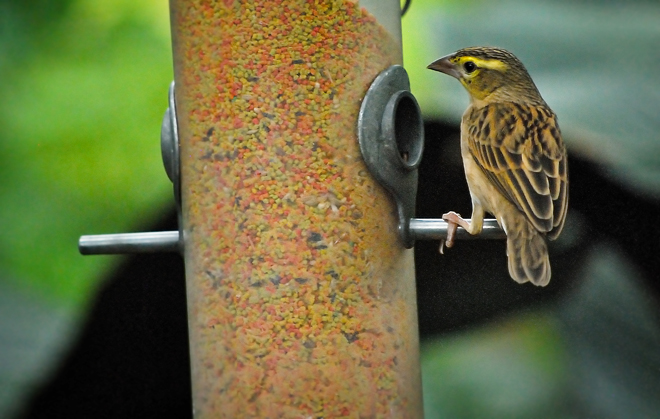
I'm naturally averse to using high ISOs. Blame it on my days as a film photographer shooting landscapes. The grain (or noise) associated with pushing film to the upper limits of speed was a price that I was seldom willing to pay. I determined never to go beyond 400 ISO. That "speed limit" was something I carried over in the switch to digital.
I'm more willing now to pay the price for the ability to shoot in low light conditions. Being paid to cover events and weddings in less than ideal lighting does that to you, I guess. You do what you gotta do to get the pictures people want. 800 ISO became my new friend, along with a software program designed to reduce digital noise.
This fella was shot at 1600 ISO -- formerly a no-man's-land for me. A very small amount of on-camera flash was used to give the bird a catchlight in its eye, but that's all. The heavy lifting was done by my camera's sensor.
Not sure that I'll make a regular practice of shooting at 1600, but with photography, at least, I've learned to never say never.
Photograph © 2010 James Jordan.




6 comments:
Did the high speed or the software distort/enhance/change the colors? House sparrows normally don't look that colorful and unless you have special seed (or cake sprinkles) in the feeder the seed looks a little too festive as well.
I don't know what they put in the bird feeders where this photo was taken (the tropical section of the Mitchell Park Conservatory in Milwaukee). The seed color is very close to what was in the feeder. And the bird was that colorful - the yellow was augmented a tad, but it was there nonetheless.
Fantastic, very nice
Ahh. I assumed it was taken in your backyard! I wonder what bird that is. It looks a lot like a female house sparrow, but the yellow by the eye is too bright.
I think the tropical section of the Mitchell Park Conservatory in Milwaukee uses sprinkles for birdseed. No wonder the house sparrow has such bright colors. :-)
I am so completely with you on the ISO issue. I became a huge fan of ISO 50 when shooting with my twin lenses medium format but rarely did I go over ISO 200 with my film selection. It has only been recently that I have been willing to venture higher with my digital camera. I am finding with digital you can push this limit more than with film and not get the adverse affects like you do with film. Great shot by the way.
Nice one, James :) I'm also more inclined to push to ISO settings beyond 800 and even to 1600 these days. The speed makes up for the cost of getting faster (and bulkier) lenses.
Post a Comment